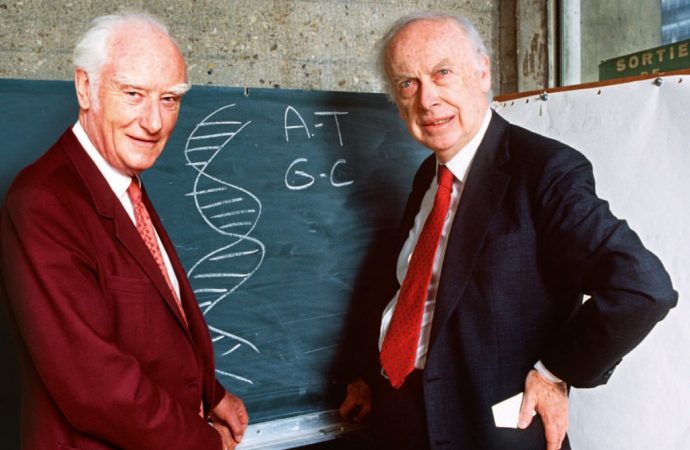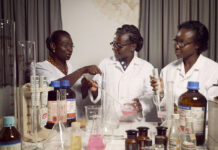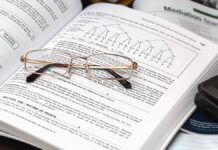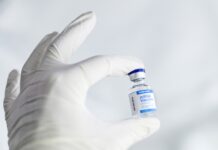The discovery of the DNA molecule
The discovery of the DNA molecule is often wrongly attributed to Watson and Crick. However, the DNA molecule was in fact first described by Friedrich Miescher. In 1869, this Swiss biochemist was trying to isolate protein components of white blood cells. After receiving the pus-coated patient bandages from the local hospital, he found that he had isolated a molecule different from any other protein component known at the time. Miescher figured that he must had found a new molecule, which he termed ‘nuclein’, precisely for being isolated from the cell nucleus. This new molecule is what we today call ‘DNA’, or Deoxyribonucleic Acid.
Miescher’s article describing the newly found molecule wasn’t published for two years, in 1871. In fact, the whole significance of Miescher’s discovery wasn’t appreciated for more than 50 years and Miescher is still an unknown figure in the history of science, both within and outside the scientific community.
DNA ratios
During World War II, the Austrian scientist Erwin Chargaff arrives in America. Influenced by Schrödinger’s book What is Life?, which proposed that the gene was a hereditary code-script, Chargaff started to work on genes and DNA. He studied the DNA of different living species and concluded, against the dogma of that time, that living species are different because of differences in their DNAs.
He concluded that the logical deduction of his first observations is that for any DNA, there is a fixed ratio of purines (Adenine and Guanine) and pyrimidines (Timine and Citosine). Many scientists may recognize what is known today as the “Chargaff’s rule”: ‘in any species the ratio of A:T is 1:1 and G:C is 1:1’.
Wilkins and Franklin
While geneticists such as Chargaff or the Russian biochemist Phoebus Levene were taking huge steps in understanding the DNA molecule, other scientists were trying to unravel the secrets of DNA using physics and chemistry.
Rosalind Franklin was one of the most influential figures at the time. Born in London, she joined the British Coal Utilization Research Association during WWII, doing investigations on the properties of coal and graphite. After the war ended, she was offered a position at the King’s College in London, with the goal of setting up and improving the Crystallography department at the University.
Meanwhile, another researcher was already working on X-ray crystallography at King’s College. Maurice Wilkins was a physics graduate that was asked to join the Manhattan Project but strongly opposed the project after the Hiroshima and Nagasaki atomic bombs. Wilkins had the opportunity of putting his idea of studying DNA using X-ray crystallography into practice at the newly-created biophysics lab at King’s College.
It was then he met Rosalind Franklin. Their relationship started on the wrong foot: by the time Franklin arrived at the King’s College, Wilkins was away on vacation. Upon his arrival, he assumed that Franklin was there to work for him as his assistant and not as an independent investigator. Due to their opposite tempers and personalities, the two couldn’t simply get along while working together.
Two enthusiastic researchers get together
In 1951, the same year Franklin joined the Kings’ College in London, a young and enthusiastic zoology graduate arrives at Cambridge. He starts working with Francis Crick, a brilliant graduate in Physics that shared Watson’s passion for genetics. Supported by Chargaff’s deduction of the DNA composition and Linus Pauling’s work on molecular models, Watson and Crick started to unravel the structure of DNA.

However, it wasn’t until Watson heard a lecture by Rosalind Franklin about X-ray images of DNA, that the discovery of the DNA structure was consolidated. Watson later admitted that he wasn’t truly paying attention to Franklin’s lecture, so he didn’t understand how her data could help his investigations. Allegedly, it was Wilkins that showed Watson the famous Photo 51 – an X-ray DNA image taken by Franklin’s assistant and used in her Nature article. Watson recalls that, after seeing Photo 51, he had no doubts about the double helix DNA model. Franklin never gave permission to Wilkins to show Photo 51 and accusations of data theft are still raised when talking about the discovery of the DNA structure.
Putting together the pieces of the DNA puzzle
After being sure about the double-helical DNA structure, Watson and Crick started to work on the final calculations to prove their DNA molecular model. In 1953, they came up with their double-helix DNA molecular model, which remains practically unchanged until today. When Watson and Crick showed it to Wilkins and Franklin, the two were certain that the model was right and agreed that the discovery should be published solely under Watson and Crick’s names. Supporting data would be published separately by Wilkins and Franklin. On the 25th of April, the Nature journal published the paper where Watson and Crick first describe the DNA structure, A Structure for Deoxyribose Nucleic Acid, as well as Wilkins’ Molecular Structure of Deoxypentose Nucleic Acids and Franklin’s Molecular Configuration in Sodium Thymonucleate.
In 1962, Watson, Crick, and Wilkins received the Nobel Prize of Medicine and Physiology, for their “discoveries concerning the molecular structure of nucleic acids and its significance for information transfer in living material”. Franklin, who left King’s College due to the terrible environment, died of cancer 4 years before. In his acceptance speech, Watson refers that “Some [people] thought Maurice was very strange, and others, including myself, thought that Francis was at times difficult. Fortunately we were working among wise and tolerant people who understood the spirit of scientific discovery and the conditions necessary for its generation”.
References
Leslie Pray (2008). Discovery of DNA structure and function: Watson and Crick Nature Education, 1 (1)
The Guardian – Sexism in science: did Watson and Crick really steal Rosalind Franklin’s data?
DNA From the Beginning
Image Credit: 40innovadoresbbva.com





